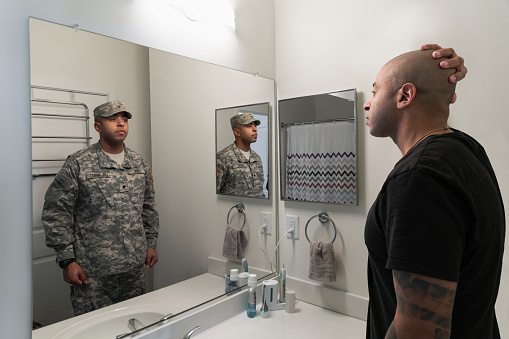Combat PTSD, Virtual Reality, and Exposure Treatment
[MUSIC PLAYING]
SKIP RIZZO: When virtual reality first came into the public consciousness, in the early to mid 90s, psychologists were starting to think this might be a great tool for exposure therapy. A number of folks started to put people in simulations of what they were afraid of. People with specific phobias. And all of a sudden they'd find that it was easier to confront their fears in the real world after confronting them in the virtual world. Fear of heights, fear of flying.
When we came about the idea of trying to develop a virtual Iraq, virtual Afghanistan scenario, it came about really from the naive impression that we could translate a video game into a political tool very easily. It was a good thing I was naive, because I knew how much work was going to be involved I might have steered away from it. One of my grad students was actually going to Iraq. He took her system over there, and actually had boots on the ground putting on the headset saying, you need this, you need that. So when our funding came in we had a whole laundry list from people that were in Iraq that were telling us with first hand experience what would be needed to make it credible.
CHRIS MERKLE: It was early morning, pre-dawn, so it was pretty dark.
SKIP RIZZO: Something like that?
CHRIS MERKLE: Yeah, perfect.
SKIP RIZZO: The key with exposure therapy it's not passive. They're encouraged to narrate their difficult experiences. Meanwhile, the clinician has the control panel. The clinician tries to emulate the elements that the patient is narrating.
CHRIS MERKLE: I got some helicopters come down here off to my left flank.
[HELICOPTER SOUNDS]
SKIP RIZZO: We can do that for just about any sensory element that you could imagine. We can even control the smell. We want people to be engaged in their trauma memory.
CHRIS MERKLE: After we pushed through Nasiriyah, we got bogged down pretty well. And then, as you got out, there are more and more fuller pieces of the vehicles, fuller pieces of the bodies. And I first noticed a bus driver.
Come up alongside that guy. I had him on my scope. I'm checking out the driver. Looks like there might be some movement. Coming along the back of the vehicle.
So looking down I just see nothing but legs, and just torsos. I see my driver. He has no legs just his lower entrails are just bubbling.
As I go to look away, I remember looking back and seeing movement. Come up on the scope, and I see him. And I swear I see his finger move, like he's like, don't shoot. And right before I shoot him I lose sight of him. I can't see him anymore.
And then, we go a little bit further, I hear pop. Somebody on one of the backdrops dumps him. And so that's pretty much what I remember of that guy. So that's my drive-through Nasiriyah.
SKIP RIZZO: You went 10 years before you could describe that day in the—
CHRIS MERKLE: Yeah.
SKIP RIZZO: —session. What was it that pulled that out of you?
CHRIS MERKLE: It was actually just this, just seeing everything, because I didn't do anything for a long time.
Just all the different range of emotions. What do you feel when you see that and it's, you know, that's another human being that he's completely gone. So it's a little difficult. And that's part of the therapy brought that back. And it's just like one of those—something that I remember completely sharply, but I never—for 10 years I never talked about.
SKIP RIZZO: You know, basically, by having somebody confront their fear, and learning that it no longer poses a threat eventually they become more comfortable. You're helping people confront, rather than avoid, and then they find out that threat doesn't exist anymore.
CHRIS MERKLE: It's those layers that the virtual reality kind of peels back. I said having that visor on, in a weird way, is like a protective helmet. Like nobody could interfere in your own little space. And you could talk about it.
SKIP RIZZO: Every now and then the issue comes up, oh, well, you're going to put somebody back in the world that caused them all that pain. Aren't you worried about re-traumatizing them? This has always been an issue that people bring up about exposure therapy.
CHRISTOPHER REIST: Exposure therapy has really been one of the more effective categories of treatment. Certainly more so than medications. It's less like going to see a therapist. And I think that makes it easier for some to participate.
SKIP RIZZO: We have advances in the technology. The graphics are getting better. The control interfaces are better.
I think we have the perfect climate to look at how these applications may benefit people clinically, aside from PTSD, for cognitive training, after a brain injury or stroke, physical training. We're not going to virtualize every form of treatment, but we're going to look very carefully at what works in the real world with traditional forms of treatment. And how can we making it better with this technology?

